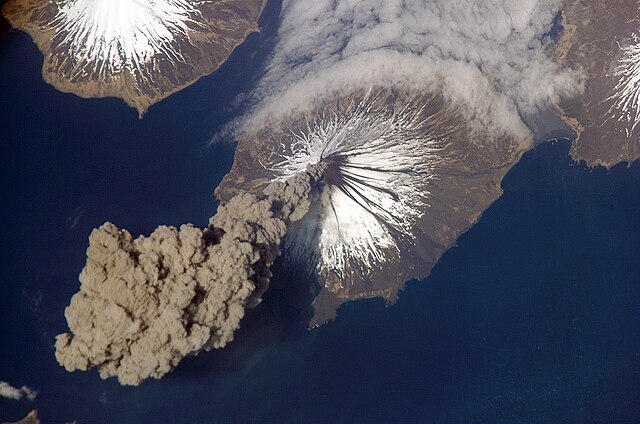Volcanic ash consists of fragments of rock, mineral crystals, and volcanic glass, produced during volcanic eruptions and measuring less than 2 mm (0.079 inches) in diameter. The term volcanic ash is also often loosely used to refer to all explosive eruption products, including particles larger than 2 mm. Volcanic ash is formed during explosive volcanic eruptions when dissolved gases in magma expand and escape violently into the atmosphere. The force of the gases shatters the magma and propels it into the atmosphere where it solidifies into fragments of volcanic rock and glass. Ash is also produced when magma comes into contact with water during phreatomagmatic eruptions, causing the water to explosively flash to steam leading to shattering of magma. Once in the air, ash is transported by wind up to thousands of kilometres away.
Ash cloud from the 2008 eruption of Chaitén volcano, Chile, stretching across Patagonia from the Pacific to the Atlantic Ocean
Ash plume rising from Eyjafjallajökull on April 17, 2010
Volcanic ash deposits on a parked McDonnell Douglas DC-10-30 during the 1991 eruption of Mount Pinatubo. While falling ash behaves in a similar manner to snow, the sheer weight of deposits can cause serious damage to buildings and vehicles. In this case, volcanic ash deposits shifted the airliner's center of gravity, leading to it resting on its tail.
Ash plume from Mt Cleveland, a stratovolcano in the Aleutian Islands
Volcanic glass is the amorphous (uncrystallized) product of rapidly cooling magma. Like all types of glass, it is a state of matter intermediate between the closely packed, highly ordered array of a crystal and the highly disordered array of liquid. Volcanic glass may refer to the interstitial material, or matrix, in an aphanitic (fine-grained) volcanic rock, or to any of several types of vitreous igneous rocks.
A sand grain of volcanic glass under the petrographic microscope. Its amorphous nature makes it disappear in cross-polarized light (bottom frame). The scale box is in millimeters.





